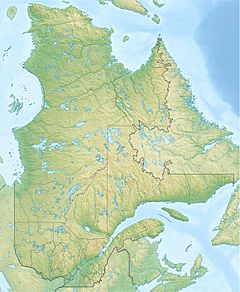Caouette Stream facts for kids
Quick facts for kids Caouette Stream |
|
|---|---|
| Native name | Ruisseau Caouette |
| Country | Canada |
| Province | Quebec |
| Region | Estrie, Chaudière-Appalaches |
| MRC | Beauce-Sartigan Regional County Municipality, Le Granit Regional County Municipality |
| Physical characteristics | |
| Main source | Mountain streams Saint-Théophile 491 metres (1,611 ft) 45°48′33″N 70°27′58″W / 45.809138°N 70.466047°W |
| River mouth | Rivière du Loup Saint-Robert-Bellarmin 372 metres (1,220 ft) 45°46′24″N 70°31′21″W / 45.77333°N 70.5225°W |
| Length | 5.6 kilometres (3.5 mi) |
| Basin features | |
| Progression | Rivière du Loup, Chaudière River, St. Lawrence River |
| River system | St. Lawrence River |
| Tributaries |
|
The Caouette Stream is a small waterway in Quebec, Canada. It's known as ruisseau Caouette in French. This stream flows through two towns: Saint-Théophile and Saint-Robert-Bellarmin. These towns are part of the Chaudière-Appalaches region.
Where is the Caouette Stream?
The Caouette Stream is located in the province of Quebec, Canada. It starts in the town of Saint-Théophile. This area is part of the Beauce-Sartigan Regional County Municipality. The stream then flows into the town of Saint-Robert-Bellarmin. This second town belongs to the Le Granit Regional County Municipality. Both of these areas are found within the larger Chaudière-Appalaches region.
Journey of the Stream
The Caouette Stream begins high up in the mountains. Its source is at an elevation of about 491 meters (1,611 feet). From there, it travels for about 5.6 kilometers (3.5 miles). The stream flows downhill, losing elevation along its path. It eventually reaches an elevation of about 372 meters (1,220 feet). The Caouette Stream then empties into the Rivière du Loup. The water from the Rivière du Loup then joins the Chaudière River. Finally, the Chaudière River flows into the mighty St. Lawrence River. This means the Caouette Stream is part of the huge St. Lawrence River system.
What's in a Name?
The name "Ruisseau Caouette" was officially recognized a long time ago. It was made official on December 5, 1968. This was done by the Commission de toponymie du Québec. This commission is in charge of naming places in Quebec.


